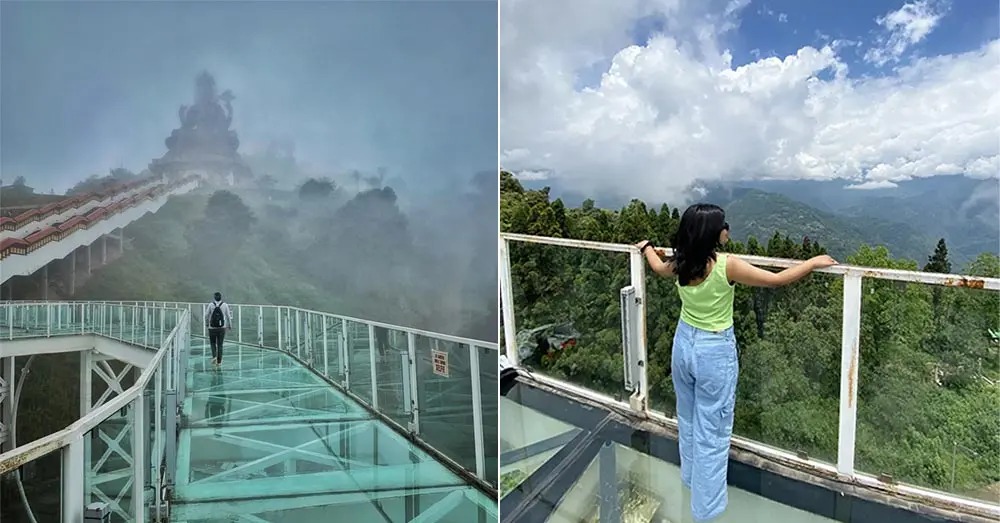India’s Glass Bridges Offer Breathtaking Panoramic Views

India’s Glass Bridges Offer Breathtaking Panoramic Views
As destinations, these bridges serve as spectacular spots for photography, videography and simply being awestruck.
13 May 2024
By Ishika Kumar
India has emerged as a prime destination for those seeking the thrill of crossing glass bridges during mountain treks and adventure trips. These are structures that blend cutting-edge engineering with stunning natural beauty.
These transparent pathways are not only feats of architectural brilliance but also provide immersive experiences of the country’s diverse landscapes, from the lush valleys of Kerala to the towering heights of the Himalayas.
The Rajgir Glass Bridge, Bihar: Located in Bihar’s Nalanda, the Rajgir Glass Bridge is the epitome of both adventure and innovation. This 85-foot-long bridge, which dangles at a precarious 200 feet above a deep gorge, offers not just a walk but an adrenaline rush. Inspired by the renowned skywalks of China, this bridge draws both domestic and international tourists, providing panoramic views of the encompassing greenery and rugged terrain surrounding it.
Unveiled by Chief Minister Nitish Kumar, the bridge promises a unique vantage point to absorb the natural splendour of Bihar. For those looking to extend their adventure, nearby nature safaris offer an additional element of excitement.
Vagamon Glass Bridge, Kerala: The Vagamon Glass Bridge claims the title of the longest cantilever glass bridge in India. Stretching over 40 metres, this skywalk is situated in an adventure park developed by the Idukki District Tourism Promotion Council, and opened its doors to the public on 6th September 2023.
This attraction provides not just a walk but an immersive experience, which is designed to instil thrill, with the bridge providing a bird’s-eye view of the lush landscapes of Vagamon below, offering a unique perspective of Kerala’s serene environment from an elevated position.
Wayanad Glass Bridge, Kerala: Further enhancing Kerala’s reputation as a unique tourist destination is the Wayanad Glass Bridge. Located in Thollayiram Kandi and owned by the private resort 900 Kandi, this bridge is perched 100 feet above the ground. It is constructed with high-strength unbreakable fibreglass imported from Italy.
It offers 30-minute sessions where visitors can enjoy sweeping views of mountains, clouds and dense forests, making every moment on the bridge a memorable one. It is accessible either by jeep or a more adventurous route via a rewarding nature trek.
Sikkim’s Sky Walk, Pelling: At an elevation of 7,200 feet, the Sikkim Skywalk in Pelling presents an unparalleled opportunity to walk ‘on thin air.’ Overlooking the imposing 137-foot-tall Chenrezig statue, which is the fourth tallest in Sikkim, this glass skywalk offers breathtaking views of the Teesta and Rangit rivers, set against the backdrop of snow-capped Himalayan peaks.
The pathway not only provides stunning vistas but also invites visitors to engage with the spiritual and tranquil ambience of the region. Available to visit from 8 am to 5 pm, the skywalk is a must-visit for those exploring Sikkim or surrounding areas, with tickets priced at just ₹50 per person.
Beyond the Adventure: Environmental and Cultural Harmony
These glass bridges do more than offer thrilling walks: they connect visitors with the profound natural beauty and cultural richness of India. Each bridge is strategically placed to showcase the best views while minimising environmental impact, incorporating advanced materials like fibreglass to ensure safety and sustainability.
As destinations, these bridges serve as spectacular spots for photography, videography and simply being awestruck. These are perfect for those looking to enhance their travel diaries with splendid pictures. Each location tells its own story, reflecting the geographical diversity and cultural heritage of India, making them not just tourist attractions but gateways to understanding the region’s natural and cultural landscapes.
In conclusion, India’s glass bridges are more than just marvels of modern engineering. They are portals to the heart of India’s environmental diversity. Offering 360-degree views of lofty hills, a stretch of varied landscapes, serene rivers and lush forests passing through, these structures invite travellers to step out of their comfort zones and into the air, experiencing India’s beauty from an entirely new perspective.
Whether you seek the thrill of height, the serenity of nature or the reverence of panoramic vistas, these bridges promise experiences that are not only share-worthy but truly unforgettable.










